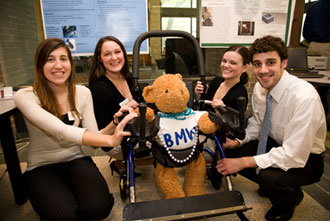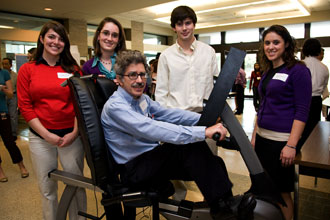Enabling the Disabled
Tulane University biomedical engineering students are gaining real-world experience by creating mechanisms that make living with disabilities easier. Twelve student teams spent Saturday (Feb. 16) showing their inventions to clients and visitors during the 2008 design show hosted by the Tulane School of Science and Engineering.

Tulane students (from left) Marie Norman, Noel Schexnayder, Molly Oehmichen and Taylor Moss show the convertible walker/stroller they built for a 4-year-old boy with a muscle weakening condition. The team earned the highest score during a biomedical engineering design show. (Photos by George Long)
Since 1989 the Team Design Projects course has offered biomedical engineering seniors a challenge in finding solutions to real problems for real clients.
"Having a real client to go to and work for enhances the experience for several reasons," says David Rice, biomedical engineering professor and course founder.
"One is that the students will buy into a project that they know will go into good hands instead of sitting on the shelf. It also prepares them to be able to communicate with clients."
Taylor Moss, leader of the highest-scoring team, says the team's goal was simple to make it easier for the client to walk and stand.
He and teammates Anne Marie Norman, Noel Schexnayder and Molly Oehmichen built a convertible walker/stroller for a 4-year-old boy with a condition that affects muscle function.
"When we met with his parents they told us that they didn't want to restrict him to a wheelchair so we really had to brainstorm," says Moss. "It was back in September when we came up with the idea for a hybrid walker/stroller combo that would help him gain muscle tone and still be able to sit down when he gets tired."

David Rice, biomedical engineering professor, seated, tries out an exercise incentive device for children with autism, designed by Rice's students, from left, Brooke Lovett, Gina Sequeira, David Ladd and Samantha Warren.
Moss says the team affectionately named the device B.M.W. at the client's request, an acronym short for "Bennett's Mobility Walker."
In its walker form, the device allows Bennett to stand and walk. If he becomes tired while walking, the device has a pull-out seat, headrest and footrest that transforms the walker into a stroller that his parents can push.
During the two-semester course students choose a client and begin the design phase of their projects in the fall with the development and testing phases continuing through the spring.
According to Rice, each team spends about 400 hours developing its project during the two semesters.
This year, the second-place student project is an exercise incentive device for children with autism. It is designed to calm behavior without disturbing fellow students in the classroom by engaging the autistic child's interest using music through earphones as a reward. The third-place project is a wheelchair communicator that allows the client to control several electronic devices from his chair with a touch-screen LCD.
